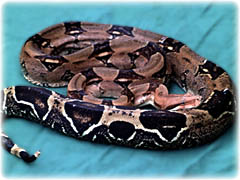| This article has been peer reviewed but is awaiting expert review. If you would like to help with this, please see more information about expert reviewing. |
Introduction
The boa constrictor (Boa constrictor) is a common pet snake of the family Boidae.
Morphology
They may grow to a length of about 4 metres (13 ft). Unlike many other boids they do not have heat-sensitive pits. The colouring tends to vary geographically but they tend to be a snake with brown or red saddles along the dorsum. There is a proliferation of names by hobbyists to describe colour forms.
Free-Living
- Distribution - Boa constrictors have a large natural range from Argentina in the south to northwestern Mexico.
- Habitat - Boas may be arboreal or terrestrial. They are often seen along rivers.
- Diet - Free-ranging boas are generalists. They feed on mammals and birds.
Captivity
Boa constrictors are very popular as pets. Captive-bred ones are less likely to be aggressive and are easier to keep.
- Cage – They require caging to reflect their size.
- Temperature - a temperature range of 25-30°C is adequate.
- Humidity - Humidity requirements are between 50-70%.
- Diet - Boas usually feed well on dead rodents.
- Reproduction – Boas are viviparous and may produce up to 50 young after a gestation period of 5-8 months.
Literature Search
Use these links to find recent scientific publications via CAB Abstracts (log in required unless accessing from a subscribing organisation).
Boa constrictor publications

